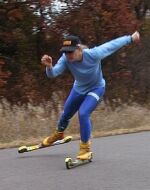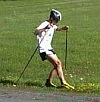Rollerskiing 101: Stopping
June 3, 2002
 In many ways, rollerskiing is the perfect off-season training
for cross-country skiing. However, one aspect doesn't translate
well: stopping. The standard snowplow won't work, nor will
a 'hockey stop'. And because a rollerski isn't as firmly attached
to your foot as an inline skate, many of the inline stopping
techniques won't work either.
In many ways, rollerskiing is the perfect off-season training
for cross-country skiing. However, one aspect doesn't translate
well: stopping. The standard snowplow won't work, nor will
a 'hockey stop'. And because a rollerski isn't as firmly attached
to your foot as an inline skate, many of the inline stopping
techniques won't work either.
There are some rollerskis on the market that offer braking
systems. These usually involve a rope or wire attached to
a level on one ski that when pulled, will apply a brake pad
to the pavement. However, these aren't like bike brakes --
they will slow you down, but usually not very quickly. Even
with such brake systems, it is still a good idea to learn
a few stopping methods.
The following are some examples of the more common methods
for stopping on rollerskis. Before attempting any of these,
it's best to find a nice, wide, flat surface with no traffic
to practice on. Wear all the proper safety gear (helmet and
pads), and if possible, have someone more experienced there
to help demonstrate and assist you.
 |
Bail out: Also known as a runout. This is the
easiest of the stopping techniques, but requires a fairly
even off-trail surface. The basic concept is to just glide
off the trail into the dirt or grass along the side. The
trick is to offset your legs and keep your weight back,
otherwise your skis will get pushed out from under you.
 Bail out #1 - Chad Giese
Bail out #1 - Chad Giese
Here is another example, with a little more "extreme"
way of stopping:
 Bail out #2 - Brian Olsen
Bail out #2 - Brian Olsen |
 |
Modified snowplow: This technique looks a bit
like a snowplow, but since the skis aren't going to slide,
you need to pick them up and reset them. Some skiers may
find it easier to do with this just one ski, rather than
alternating between skis.
 Modified Snowplow - Beth Kolb
Modified Snowplow - Beth Kolb |
 |
Ski drag: Also known as a t-stop. This one is
very similar to the inline skate t-stop. It is generally
harder to learn and requires the ability to balance well
on one ski. It also can wear the wheels out a lot faster,
but when used properly, can be one of the faster ways
to stop.
 Ski drag - Per Nelson
Ski drag - Per Nelson |
Thanks to Chad Giese (Subaru Factory Team), and Beth
Kolb, Brian Olsen, Sonne Nordgren (Minnesota Biathlon), and
Per Nelson (Skinnyski.com Racing Team), for their gracious
assistance in demonstrating these techniques.
Related links
|



